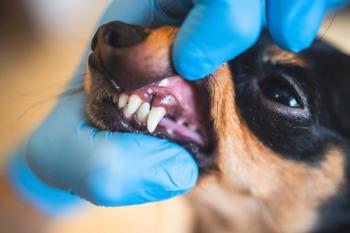
Orthodontics defined
What is meant by the words overbite, open bite, overjet, level bite, overshot, underbite, anterior crossbite, wry bite, lingually displaced or base narrow canines?
What is meant by the words overbite, open bite, overjet, level bite, overshot, underbite, anterior crossbite, wry bite, lingually displaced or base narrow canines?
Veterinarians and others who want to express specific dental conditions in dogs and cats need to use the proper terms. This article will review commonly used and misused words to describe tooth alignment.
Photo 1 (top left): Normal scissors occlusion in a mesocephalic dog. Photo 2 (top right): Even space between the mandibular canine and the maxillary canine and lateral incisor. Photo 3 (bottom left): The cusp of the mandibular fourth premolar points to the space between the maxillary third and fourth premolars. Photo 4 (bottom right):The maxillary and mandibular cusps do not interdigitate normally indicating an inherited skeletal malocclusion.
Dogs normally have 28 deciduous (primary or baby) teeth that erupt during the first six months of life. Most breeds have 42 adult teeth. Cats have 26 deciduous and 30 adult teeth. There are four types of teeth. Incisors are the smaller teeth located between the canines on the upper and lower jaws.
Anatomy
They are used for grasping food and help keep the tongue within the mouth. Canines (also called cuspids or fang teeth) are located on the sides of the incisors and used to grasp food. Premolars (bicuspids) are for shearing or cutting food and are located behind the canines. The molars are the last teeth in the mouth. They are used for grinding nourishment for entry into the esophagus.
Photo 5 (top left): Mandibular incisor crowding typical of class I malocclusion. Photo 6 (top right): Class II brachygnathia overjet. Photo 7 (bottom left): Class II prognathia underbite. Photo 8 (bottom right): Ulcerated mandibular gingiva from maxillary canines.
The way teeth align with each other is termed occlusion. Normal occlusion in most medium and long-nosed breeds consists of the upper (maxillary) incisors just overlapping the lower (mandibular) incisors (scissor bite). (See Photo 1.) The lower canine should be located equidistant between the last (lateral) incisor and the upper canine tooth (Photo 2). The premolar tips of the lower jaw should point between the spaces of the upper jaw teeth (Photos 3 and 4).
Malocclusion refers to abnormal tooth alignment. Overbite (overshot, class two, overjet, mandibular brachygnathism) occurs when the lower jaw is shorter than the upper (Photo 6). There is a gap between the upper and lower incisors when the mouth is closed. The upper premolars are displaced at least 25 percent toward the front when compared to the lower premolars. An underbite (undershot, reverse scissor bite, prognathism, class 3) occurs when the lower teeth protrude in front of the upper jaw teeth (Photos 7, 8) If the upper and lower incisor teeth meet each other edge to edge, the occlusion is an even or level bite (Photo 11). When the upper and lower incisors do not overlap or even meet each other when the mouth is closed, the pet has an open bite . Anterior crossbite occurs when the canine and premolar teeth on both sides of the mouth occlude normally, but one or more of the lower incisors are positioned in front of the upper incisors (Photo 12). Anterior crossbite is the most common malocclusion, is not considered genetic or hereditary and is correctable. Posterior crossbite occurs when one or more of the premolar lower jaw teeth overlap the upper jaw teeth. This is a rare condition that occurs in the larger-nosed dog breeds. A wry mouth or wrybite occurs when one side of the jaw grows longer than the other. Lingually displaced mandibular (base narrow)canines occur when the mandibular canine teeth protrude inward causing penetrating damage to the upper palate. This condition is due to either persistent primary teeth or a too-narrow mandible and can usually be corrected through an orthodontic appliance (inclined plan) used to direct the teeth into normal occlusion. Rostrally deviated canine teeth occur when the maxillary or mandibular canine is directed forward and can usually be corrected by orthodontic movement, crown reduction or extraction.
Malocclusion
Photo 9 (top left): Wry bite canine. Photo 10 (top right): Wry bite feline. Photo 11 (bottom left): Level bite. Photo 12 (bottom right): Anterior crossbite (maxillary left central incisor in reverse scissors occlusion).
In future editions of DVM Newsmagazine, therapies of the most common dental conditions will be featured.
Newsletter
From exam room tips to practice management insights, get trusted veterinary news delivered straight to your inbox—subscribe to dvm360.






